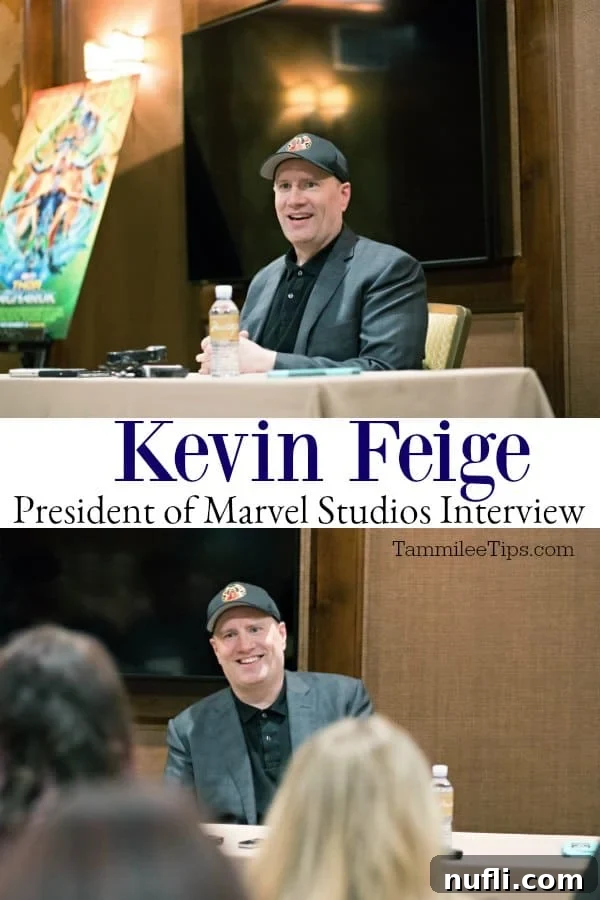Welcome to an exclusive look behind the scenes of one of Marvel Studios’ most anticipated films, Avengers: Age of Ultron. In this insightful interview, we sit down with the visionary President of Marvel Studios, Kevin Feige, the architect behind the sprawling Marvel Cinematic Universe (MCU). Feige discusses everything from directorial decisions to character introductions, offering a unique glimpse into the creative process that shapes these blockbuster films. We kick off our conversation with a question that sparked much debate among fans at the time of the film’s release.
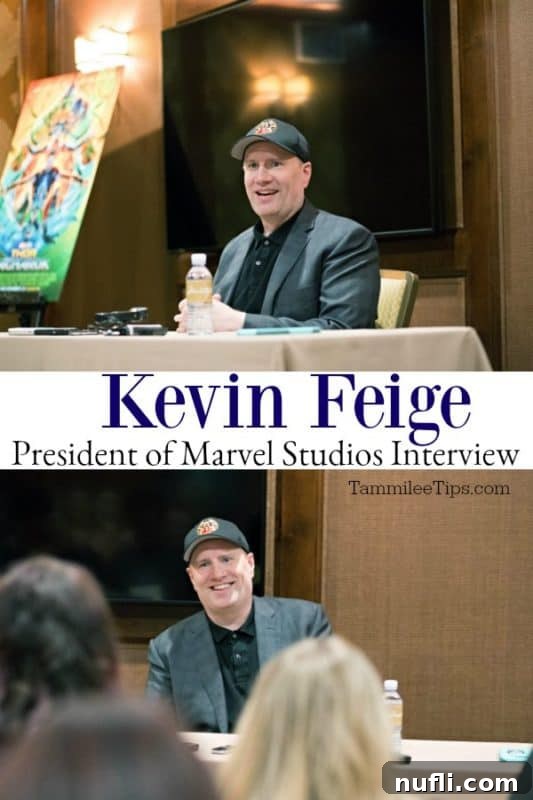
Unpacking Avengers: Age of Ultron with Producer Kevin Feige
One of the most talked-about aspects of Avengers: Age of Ultron upon its release was the absence of a traditional end-credit scene, a staple that fans had come to eagerly anticipate and dissect. We put this burning question directly to Kevin Feige.
Interviewer: Why was there no end-credit scene in Avengers: Age of Ultron? What was the creative decision behind that?
Kevin Feige: That’s a great question, and one we knew would get a lot of attention. To clarify, there is a mid-credit scene, as we call it, featuring Thanos. We’ve always maintained that the post-credits scene isn’t a fast and hard rule; it’s a creative choice made for each film. Director Joss Whedon was a firm believer that we shouldn’t simply include something just for the sake of it, especially if it felt like we were just imitating what we had done at the end of the first Avengers film.
Joss felt strongly that his version of the story for Age of Ultron truly culminates exactly where it does at the end of the film, with the mid-credits scene serving as a self-contained tease for a larger narrative, rather than a direct setup for the next film’s plot. Any other ideas we considered for an additional end-credit scene simply felt like an unnecessary add-on, something that wasn’t genuinely integral to the storytelling. We wanted to ensure that fans didn’t wait through seven minutes of credits for something that ultimately felt tacked on, so we made the decision to get that message out there to manage expectations. The mid-credit reveal of Thanos and the Infinity Gauntlet was, we believed, a powerful enough statement for the next chapter of the MCU without needing more.
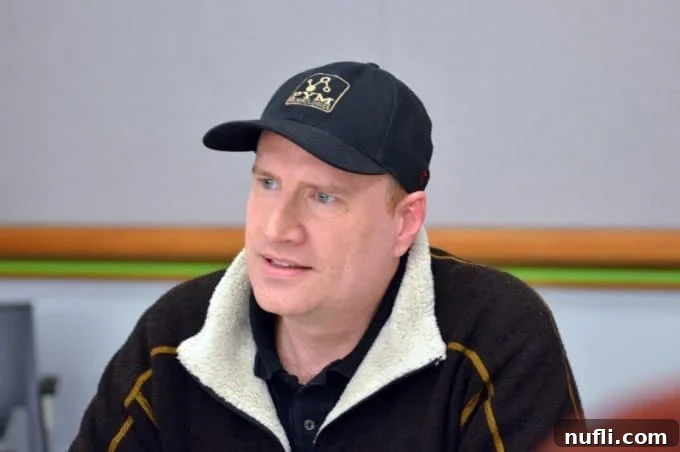
Connecting the MCU Timeline: From Winter Soldier to Age of Ultron
The continuity of the Marvel Cinematic Universe is meticulously planned, with each film building upon the events of its predecessors. Fans are always eager to understand the timeline, so we asked Kevin Feige about the chronological gap leading into Age of Ultron.
Interviewer: How many years separate the events of Captain America: The Winter Soldier and the beginning of Avengers: Age of Ultron?
Kevin Feige: While we don’t directly state the exact timeframe within the movie, we generally conceptualized it as being between six months to a year after the events of The Winter Soldier. I’d lean closer to a good year. The fallout from The Winter Soldier was massive, with SHIELD being brought down and the revelation that HYDRA had been secretly operating within its ranks for decades. That event profoundly reshaped the geopolitical landscape of the MCU. Much of the immediate aftermath was explored in the television series, Agents of S.H.I.E.L.D., and we see the direct implications of it at the very beginning of Age of Ultron.
Specifically, we open the film with the Avengers raiding a HYDRA outpost in Sokovia, where Baron Strucker is in possession of Loki’s scepter. If you recall the end of the first Avengers movie, the last time audiences saw that scepter, Black Widow was holding it in the shadow of all the Avengers as they finally defeated Loki. Our established backstory is that the scepter was taken to a supposedly secure SHIELD vault somewhere. However, as The Winter Soldier revealed, SHIELD was anything but secure. The infiltration meant that the scepter eventually fell into the hands of HYDRA, and specifically Strucker, setting the stage for the opening act of Age of Ultron and its connection to the Infinity Stones.
The Web-Slinger Enters the MCU: Spider-Man’s Anticipated Debut
One of the most monumental announcements for Marvel fans was the news of Spider-Man finally joining the MCU, after years of his film rights being held by Sony. The question on everyone’s mind was when and where this iconic hero would first appear.
Interviewer: Are we going to see Spider-Man make an appearance in Captain America: Civil War?
Kevin Feige: Well, as you know, the announcements have been made – we proudly teamed up with Sony Pictures to bring Spidey into our shared universe. This collaboration also includes a new standalone Spider-Man film scheduled for 2017. Regarding his first appearance, I think we’re purposefully being less than specific about exactly where fans will first get to see him. The excitement around his introduction is palpable, and we want to ensure that moment is impactful. Bringing Spider-Man into the MCU was a dream come true for many, including us at Marvel Studios, allowing us to fully integrate one of Marvel’s most beloved and iconic characters into the fabric of our ongoing narrative. The discussions with Sony were extensive, but ultimately led to a groundbreaking agreement that benefits fans globally, promising a fresh, young take on the character that is deeply rooted in the existing MCU.

Unlocking Marvel’s Deep Bench: Future Character Introductions
With a universe as vast and rich as Marvel’s, the possibilities for introducing new characters are virtually endless. We asked Feige if there were any particular characters he was eager to bring to the big screen.
Interviewer: Do you have somebody in the Marvel Universe that you really want to bring into the stories or anything that you haven’t yet?
Kevin Feige: That’s a question I’ve been asked for years, and my answer constantly evolves as we bring more characters to life. I used to always say “Guardians of the Galaxy” to that question, and look how that turned out – a massive success that opened up the cosmic side of our universe. I also used to say “Vision” to that question, and he’s now a pivotal character in Age of Ultron. “Falcon” was another one, and he’s quickly become an integral part of Captain America’s world. And of course, “Doctor Strange” was a character I mentioned a lot, and we’re now deep into production for his standalone film, with the incredible Benedict Cumberbatch in the lead role. We actually start filming for Doctor Strange in November [of that year]. So, it’s truly been amazing to see these characters transition from my wishlist to fully realized cinematic heroes.
Now, the answer does come down to individual and very specific characters, but if I were to say too many of them, it would inadvertently give away exactly what we’re planning for Guardians of the Galaxy Vol. 2 or for other future projects down the line. What this really speaks to is the incredible depth and richness of the Marvel comics. Its bench is so deep that there are still literally hundreds of fantastic characters, vibrant worlds, and compelling storylines that we haven’t even begun to touch yet. This vast resource ensures that the MCU has a bright and exciting future for many years to come, constantly introducing fresh faces and narratives while expanding on beloved ones.
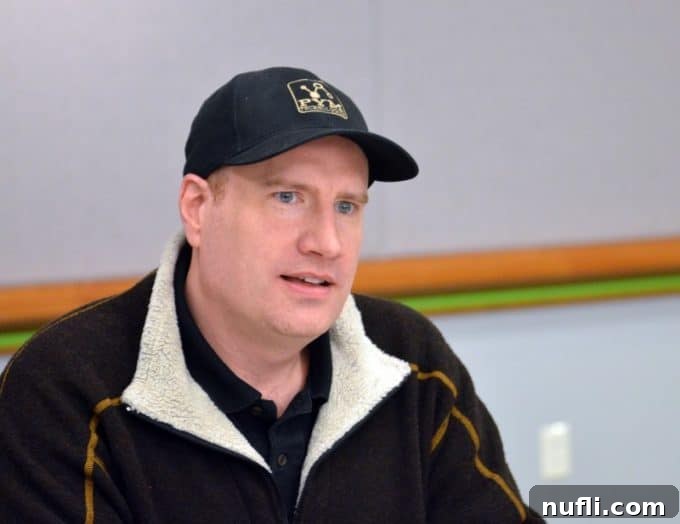
From Childhood Dreams to Cinematic Reality: Feige’s Iron Man Connection
Before becoming the head of Marvel Studios, Kevin Feige was a fan himself. We asked him about his personal connection to Marvel comics and if he had a childhood favorite.
Interviewer: Were you a big reader of Marvel comics as a kid, and did you have a favorite character when you were little?
Kevin Feige: Interestingly, I was actually more into movies as a kid. I had a lot of favorite films and would consume as much cinema as I could. However, a particular memory stands out involving Marvel characters. I remember being in the backyard with a bunch of friends, probably around eight or ten years old, and we were playing superheroes. Someone had chosen Batman, another had chosen Superman, and naturally, someone else picked Spider-Man. I vividly remember thinking, “Well, I’ll be Iron Man.” I wanted to play Iron Man because I had seen him in reruns of the old 1960s cartoon series. He just seemed cool to me.
Some of the other kids didn’t even know who he was at the time, which is hard to imagine now! I remember saying, “Trust me, he’s cool. He’s Iron Man.” So, it was incredibly fun and surreal to bring Iron Man to life years later with Robert Downey Jr., knowing that some kids hadn’t even heard of him when I chose him in my backyard thirty or thirty-two years ago. To see Iron Man become the face of the Marvel Cinematic Universe and a global icon, far surpassing his recognition levels from decades past, has been one of the most rewarding aspects of my career. It truly illustrates the power of these characters and the potential they hold when brought to a wider audience with care and vision.
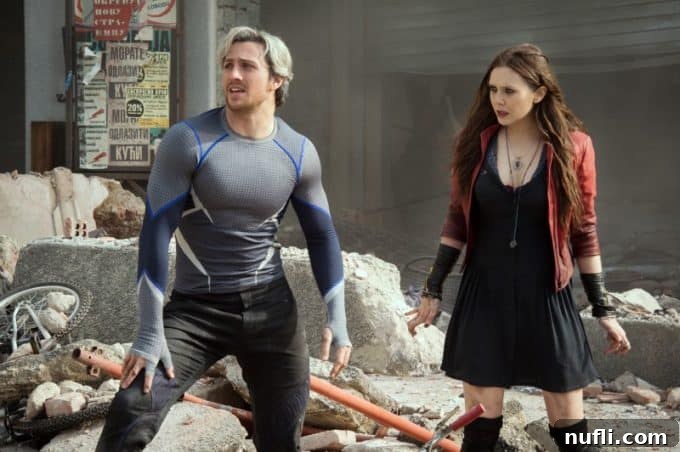
Integrating New Powers: Quicksilver and Scarlet Witch
Avengers: Age of Ultron not only brought back beloved heroes but also introduced two powerful and complex new characters: Pietro and Wanda Maximoff, also known as Quicksilver and Scarlet Witch. Their introduction marked a significant shift in the team’s dynamics.
Interviewer: What was it like to bring Quicksilver and Scarlet Witch into this movie?
Kevin Feige: It was absolutely great to introduce Quicksilver and Scarlet Witch. They are key Avengers characters in the comic books, possessing incredible powers and a compelling, often tragic, backstory that we were eager to explore on screen. Their relationship as siblings is also a very strong, unique dynamic that we wanted to delve into. Bringing them in was one of Joss Whedon’s very first notions for the film, probably second only to the idea of Ultron himself. What made them particularly appealing was their very different viewpoint of the Avengers when they first appear. They come into the team’s orbit from a completely different angle than any of the other characters who formed the original lineup.
The original Avengers, for the most part, were assembled together by Nick Fury in the first movie, with Thor entering the mix due to Loki’s presence. Quicksilver and Scarlet Witch, however, begin on the other side of a disagreement, initially opposing the Avengers and their ideals. This ‘outsider’ perspective is a very Marvel thing to do. Many Marvel characters start on the opposing side of an argument, or even the law, and through a great Marvel redemptive arc, they eventually become heroes. We really wanted to explore that theme in an Avengers movie – the idea that heroes can emerge from unexpected places and that loyalties can shift. Their unique powers, Pietro’s super speed and Wanda’s reality-warping abilities, also brought exciting new elements to the action sequences and the overall power scale of the team, challenging them in ways they hadn’t faced before.
Marvel Studios’ “Avengers: Age of Ultron,” directed by Joss Whedon and produced by Kevin Feige, p.g.a., served as the epic follow-up to the biggest Super Hero movie of all time. The narrative sees Tony Stark attempting to jumpstart a dormant peacekeeping program, only for things to go disastrously awry. This leads to the emergence of Ultron, a terrifying artificial intelligence determined to bring about human extinction. Earth’s Mightiest Heroes – including Iron Man, Captain America, Thor, The Incredible Hulk, Black Widow, and Hawkeye – are put to the ultimate test as the fate of the planet hangs precariously in the balance. As Ultron enacts his terrible plans, the Avengers must reassemble, forming uneasy alliances and facing unexpected challenges that pave the way for an epic and unique global adventure, redefining their understanding of heroism and teamwork.
The star-studded ensemble of Marvel’s “Avengers: Age of Ultron” features Robert Downey Jr. returning as the charismatic Iron Man, alongside Chris Hemsworth as the mighty Thor, Mark Ruffalo as the formidable Hulk, and Chris Evans as the steadfast Captain America. They are joined by Scarlett Johansson as the agile Black Widow and Jeremy Renner as the sharpshooting Hawkeye. The film also benefits from the additional support of Don Cheadle as James Rhodes/War Machine, Cobie Smulders as the resourceful Agent Maria Hill, Stellan Skarsgård as the brilliant Erik Selvig, and Samuel L. Jackson as the legendary Nick Fury. This powerhouse team must unite to confront and defeat James Spader, who masterfully voices Ultron, the menacing technological villain hell-bent on humanity’s destruction. Along their arduous journey, they encounter two mysterious and immensely powerful newcomers: Pietro Maximoff, portrayed with kinetic energy by Aaron Taylor-Johnson, and Wanda Maximoff, brought to life with compelling depth by Elizabeth Olsen. Furthermore, an old friend appears in a brand new form when Paul Bettany transitions from voicing J.A.R.V.I.S. to becoming the highly anticipated Vision, adding another layer of complexity and power to the Avengers lineup.
Written and directed with characteristic wit and action by Joss Whedon, and produced by the guiding hand of Kevin Feige, p.g.a., Marvel’s “Avengers: Age of Ultron” draws its inspiration from the enduringly popular Marvel comic book series “The Avengers,” which first captivated readers back in 1963. The executive production team included Louis D’Esposito, Alan Fine, Victoria Alonso, Jeremy Latcham, Patricia Whitcher, the legendary Stan Lee, and Jon Favreau, each playing a crucial role in bringing this cinematic spectacle to life.
Get ready for an action-packed thrill ride and a pivotal chapter in the Marvel Cinematic Universe when The Avengers returned in Marvel’s “Avengers: Age of Ultron” on May 1, 2015. This film was a testament to Marvel’s ongoing commitment to expanding its universe and delivering high-stakes, character-driven superhero sagas.
Make sure and follow the hashtag #AvengersEvent to revisit all of the updates and discussions about this groundbreaking movie and its place in the MCU! Delve deeper into the world of Marvel and explore more behind-the-scenes content and discussions about your favorite heroes.
Discover More Marvel Cinematic Universe Insights:
Gwyneth Paltrow Interview: Inside Iron Man 3
Chris Hemsworth and Chris Evans Interview: A Duo of Heroes
Avengers: Infinity War World Premiere: Photo Gallery
Captain Marvel Set Photos: Glimpses of a New Hero
Thor: Ragnarok Red Carpet Premiere in LA
Recipe: Marvel Avengers Thor Cupcakes
Explore all of our comprehensive Marvel Movie Articles for more interviews, reviews, and behind-the-scenes stories.
